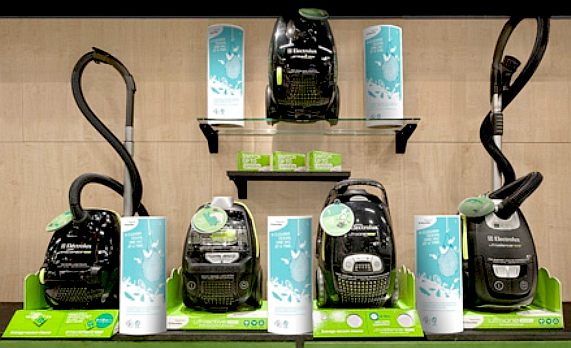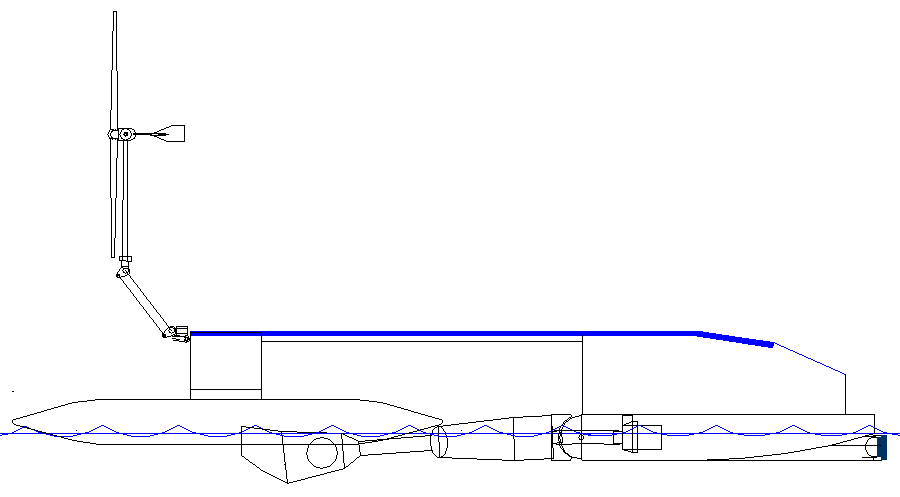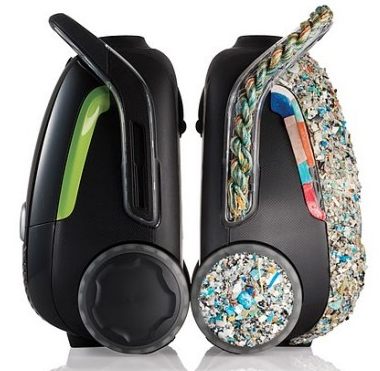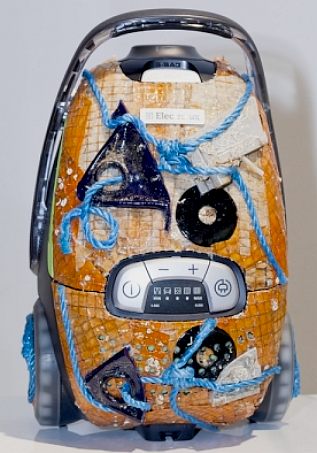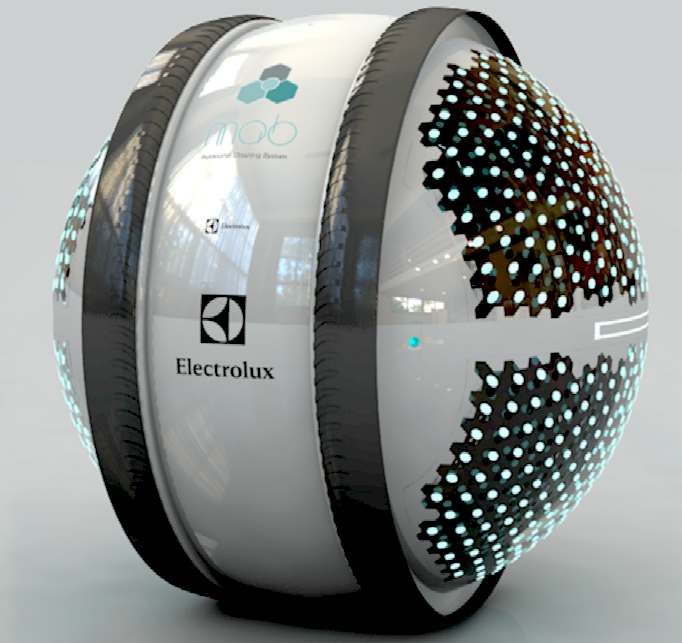|
ELECTROLUX - VACUUM CLEANERS FROM OCEAN PLASTIC
|
||
|
Each of the five vacuum cleaners sports a casing made from plastics found in a different body of water, including the Pacific Ocean, Indian Ocean, North Sea, Mediterranean Sea, and Baltic Sea. The casing is put over the fully functional core structure of the new Electrolux Ultra One Green model. They each show how plastic pollution is a universal problem, yet the details of the problem are specific to different areas. For example: The plastic that was collected on the Bohuslan beaches in western Sweden consists largely of various rinse aid and detergent bottles, cans, plastic buckets, and all kinds of plastic packaging. The plastic has not been bleached in the same way as in the great oceans. It is still loud and strong in color. A lot of the found plastic was also drenched in spill oil.
ELECTROLUX PROJECT VAC FROM THE SEA
According to Electrolux,
the Swedish appliance manufacturer, there are gigantic piles of plastic debris floating about our planet’s oceans? Some of these are as big as the state of Texas! Way to go, humans! So, Electrolux’s proposal? Collect all that trash, then turn it into vacuum cleaners.
It's called recycling and that is not such a crazy idea as many think.
The company partnered with organizations and volunteers to collect the plastics, making the project a big opportunity to educate people about the problem of plastics in our oceans. Electrolux recognizes how much plastic it uses for its products, and that they have a big impact. While making cases from collected plastic isn't exactly a sustainable business operation, it does help center the company's focus on reducing its plastics waste and getting consumers to recycle.
Interesting
displays of plastic inside these Electrolux machines. Electrolux South Africa General Manager Stuart Spencer
is quoted as saying that the Vac from the Sea project was run internationally in 2010 to great acclaim.
ABOUT ELECTROLUX'S VAC FROM THE SEA
Vac from the Sea is a project initiated by home appliance maker Electrolux, aiming at raising awareness about the immediate need for the world to take better care of plastics and support the heroes that do.
WHY?
HOW?
A limited number of vacuum cleaners will be made from marine plastic debris – harvested from the Pacific and other sites where the plastic problem is immense.
Electrolux intend to collect the plastic with a minimum environmental impact. This is one reason why they are taking help from organizations that already exist and are engaged in the issue.
Depending on the local plastic situation the gathering of plastics will vary – from diving among coral reefs, clean-ups closer to shore to scooping up plastic directly from the water surface. The vacuum cleaners that are to be produced from the material gathered will be put on display for the world, decision makers and consumers to see.
At this point, there is no plan to actually sell the units produced. Separating the plastic cocktail is a great challenge and plastics in the ocean tend to act like sponges for other toxins.
WHERE?
The locations where plastic will be collected are in the Pacific Ocean, the Indian Ocean, the Atlantic Ocean, the Mediterranean Sea, the Baltic Sea and the North Sea. The gathering of material will be documented on their website.
PLASTICS TODAY, SEPTEMBER 2011
Household and personal care company Method has launched bottles made in part from plastic collected from the North Pacific Gyre. The bottles are 100% post-consumer polyethylene, with 25% of the PCR content sourced from the ocean. Method has partnered with recycler Envision Plastics on the project, calling the resulting plastic Ocean PCR. "For every [bottle] you buy, you take 15 grams of plastic out of the ocean," is how Method cofounder Adam Lowry describes the product's impact. 2.
How do you establish a supply chain for a material that's floating in the ocean 2000 miles off the West Coast?
Youtube Elextrolux
EARTH
TIMES NOV 2010
In the Mediterranean, plastic waste collected from beaches at St Cyr-sur-Mer, France, was mostly litter from tourism such as food containers, beach toys and drink cans. This plastic was cut into pieces and attached to a thin shell of recycled plastic.
The quest will be documented and communicated throughout the project on their website, the Electrolux Facebook page www.facebook.com/electroluxappliances as well as the Twitter page www.twitter.com/vacfromthesea. Well done to Electrolux.
THE WORLD'S LARGEST VACUUM CLEANER - The above is a proposed trimaran test rig, using the above off-the-shelf components, just to get a feel for the concept. This is in no way a complete solution, but then we have to start somewhere. What we learn from these small scale experiments, could eventually help us to formulate a dual purpose, ocean capable cruiser, to clean up the English Channel and local harbors, with a view to cleaning up the marine environment and improving the quality of beaches and locally caught fish, etc. Full size, this autonomous vessel could harvest up to 50 tons of plastic, before it needs to offload. How many Electrolux vacuum cleaners would 50 tons make?
TREEHUGGER
OCT 2010
Electrolux
ocean friendly vacuum cleaners are made from recovered plastic. On the
right is the Atlantic edition. From 15 to 21 November 2011, the Two Oceans Aquarium
presented Vacs from the Sea. Local artist and originator of Plastikos Simon Max Bannister partnered with Electrolux on its Vacs from the Sea maritime conservation initiative and created
artwork using an eco-friendly vacuum cleaner as his canvas and incorporating recycled plastic gathered from beach clean-ups that took place at Muizenberg and Hout Bay in September 2011.
LEFT
- The Electrolux Trilobite is a robotic vacuum cleaner from the famous Swedish domestic
consumer company. The prototype cleaner was first seen on the BBC television programme, "Tomorrow's World", in 1997, when it was demonstrated by presenter Philippa Forrester. It was the world's first commercially available autonomous vacuum cleaner, introduced as a product in 2001.
RIGHT - Flying mini-robot cleaners win Electrolux Design Lab 2013 Contest. Stefano Marzano, Chief Design Officer at Electrolux and Head of Jury is quoted as saying: “This year’s winning concept renews the idea of looking at the robot, seeing it not as one unit that mimics a person, but instead as something inspired by the magical logic of nature’s collaborative efforts and group intelligence.” “The Mab is an innovative concept which could be relevant to minimize the daily cleanings efforts of consumers as well as businesses, while maximizing the results”
UNITED NATIONS ENVIRONMENT PROGRAM
The United Nations Environment Program says around 13,000 pieces of plastic litter are found in every square kilometer of sea, but the problem is worst in the North Pacific. The plastic particles are being vacuumed up by marine life and birds, and the mix is heavy with toxic chemicals. Read a summary of their 2014 report by clicking on the heading to this paragraph.
LINKS
Treehugger vacuum cleaners made from ocean plastic highlight ugly pollution beautiful design Techcrunch 2010 Electrolux will clean the oceans of plastic debris then make vacuum cleaners Earthtimes vacuums-ocean-plastic Plastics today bottles utilize plastic scrap retrieved pacific gyre Bigthink cleaning up the oceans with a vacuum cleaner Aquarium vacs_from_the_sea_on_exhibit_at_the_two_oceans Electrolux group flying mini robot cleaners win electrolux design lab competition 2013 http://www.electroluxgroup.com/en/flying-mini-robot-cleaners-win-electrolux-design-lab-2013-contest-18007/ http://www.aquarium.co.za/blog/entry/vacs_from_the_sea_on_exhibit_at_the_two_oceans_aquarium/ http://www.plasticstoday.com/articles/bottles-utilize-plastic-scrap-retrieved-pacific-gyre0916201101 http://bigthink.com/design-for-good/cleaning-up-the-oceans-with-a-vacuum-cleaner http://www.electrolux.co.uk/Innovation/Campaigns/Vac-from-the-sea1/ http://www.electrolux.co.uk/Innovation/Campaigns/Vac-from-the-sea1/Articles/FAQ---about-Vac-from-the-Sea/ http://techcrunch.com/2010/06/24/electrolux-will-clean-the-oceans-of-plastic-debris-then-make-vacuum-cleaners/ http://www.earthtimes.org/business/vacuums-ocean-plastic/24/
ARCTIC - ATLANTIC - BALTIC - BERING - CARIBBEAN - CORAL - EAST CHINA - ENGLISH CH - GULF MEXICO
INDIAN - MEDITERRANEAN - NORTH SEA - PACIFIC - PERSIAN GULF - SEA JAPAN - STH CHINA
PLASTIC
ENGLAND - PLASTIC
OCEANS
|
||
|
This website is Copyright © 2015 Bluebird Marine Systems Ltd. The names Bluebird™, Bluefish™, Ecostar DC50™, SeaNet™, SeaVax™ and the blue bird and fish in flight logos are trademarks. CONTACTS The color blue is a protected feature of the trademarks.
|



